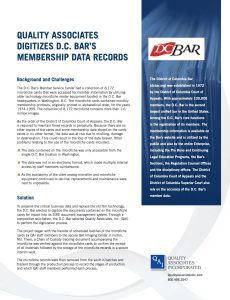Background and Challenges
The D.C. Bar’s Member Service Center had a collection of 8,172 microfiche cards that were accessed for member information by utilizing older technology microfiche reader equipment located in the D.C. Bar headquarters in Washington, D.C. The microfiche cards contained monthly membership printouts, originally printed in alphabetical order, for the years 1974-1999. The collection of 8,172 microfiche contains more than 1.6 million images.
By the order of the District of Columbia Court of Appeals, the D.C. Bar is required to maintain these records in perpetuity. Because there are no other copies of the cards and some membership data stored on the cards exists in no other format, the data was at risk due to misfiling, damage or deterioration. This could result in the loss of the data forever. Other problems relating to the use of the microfiche cards included:
- The data contained on the microfiche was only accessible from the single D.C. Bar location in Washington.
- The data was not in an electronic format, which made multiple internal access by staff members cumbersome.
- As the availability of the older analog microfilm and microfiche equipment continued to decline, replacements and maintenance were next to impossible.
Solution
To preserve the critical business data and replace the old film technology, the D.C. Bar elected to digitize the documents contained on the microfiche cards for import into its SIRE document management system. Through a competitive solicitation, the D.C. Bar selected Quality Associates, Inc. (QAI) to perform the digitization process.
The project began with the transfer of scheduled batches of the microfiche cards by QAI staff members to the secure QAI Imaging Center in Fulton, Md. There, a Chain of Custody tracking document accompanying the microfiche was verified against the microfiche cards to confirm the receipt of all materials followed by the storage of the microfiche records in a secure interim vault.
The microfiche records were then removed from the vault in batches and tracked through the production process to record the stages of production and which QAI staff members performed each process.
Solution (continued)
Scanning the microfiche was accomplished using the Mekel Mach VII Microfiche Scanner which provided advanced digitization capabilities including:
- Auto-correction for poor or low-quality original microfiche
- Real-time image sharpening and enhancement
- Advanced adaptive Automatic Gain Control (AGC), which handles varying film density in real-time across the fiche
- Full 8,192-pixel CCD array for highest optical dpi in the industry
- Real-time automatic and manual control of rotation, cropping, de-skew and automatic compression of film background density variations
Once the digitized records were inspected for quality, the microfiche cards and digital copies were delivered to the D.C. Bar for uploading into its SIRE host application.
Results
The digitization process provides the D.C. Bar with improved access to the data by multiple users through the Bar’s SIRE Content Management System. Users no longer need to access the data one at a time through the old analog microfiche media, and are now able to view the Membership Records from their desktop computers.
The digitized data also provides the D.C. Bar with the capability to “back up” the digital files and generate archival storage versions for secondary/protected storage, thus meeting the District of Columbia Court of Appeals’ requirement to maintain the records in perpetuity.
Additional digitization efforts performed by QAI for the D.C. Bar include the scanning and Optical Character Recognition (OCR) processing of older/ archive copies of magazine publications and newsprint sheets such as the Bar Report, Washington Lawyer and District Lawyer.


